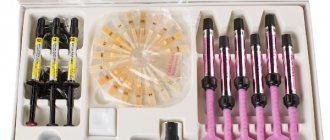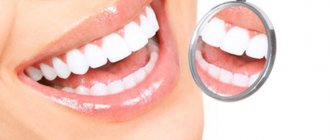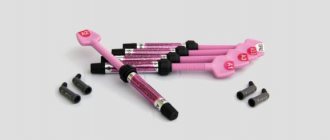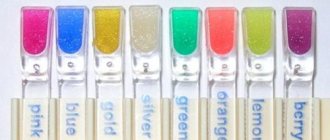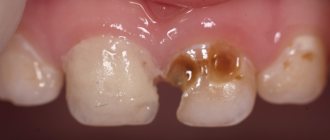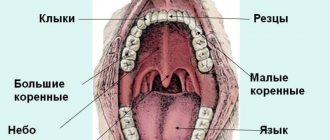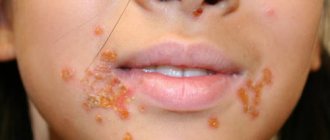24.11.2019
An allergy is an increased sensitivity to certain substances that causes painful symptoms. An allergy to a filling is quite rare, but still, each human body is special, and can react differently to a filling composition that is foreign to it. Any material introduced into the human body from the outside can cause a toxic reaction.
How does an allergy to a filling manifest itself and what can it be confused with?
An allergic reaction to a filling is manifested by redness and swelling of the gums, aching pain, and an atypical taste in the mouth. But these symptoms may indicate the consequences of treatment (especially if it was carried out with the removal of a nerve or surgical opening of the gum), and an allergy caused by an anesthetic medication. In these cases, the unpleasant sensations disappear within a few days, usually two or three, less often a week.
If pain, redness and swelling do not subside over a longer period of time, this indicates an allergy to some component of the filling material. Symptoms may subside when taking an antihistamine (anti-allergy) drug, but then appear again - because contact with the allergen does not stop. Moreover, the symptoms worsen, possibly an increase in body temperature, the appearance of a rash and itching, and the spread of swelling to the facial area.
Poor quality root canal filling
A canal that is not completely sealed or an “additional” branch that is not noticed during treatment and remains without filling will not initially cause discomfort to the patient. But slowly and surely, pathogenic microflora will penetrate into poorly sealed canals.
And at a certain point, after months or even years, the tooth will begin to ache, and the pain will intensify when chewing food.
The cause of the pain is explained by the changes that occurred during this time in the bone tissue near the apex of the affected root. In some patients it is noticeably discharged, in others a granuloma forms due to infection, and in others there is a need for treatment of a dental cyst.
Allergy to temporary filling
A temporary filling is installed for a period of several hours to 2-3 weeks, mainly for diagnostic purposes - to determine how infected the pulp (neurovascular tissue of the tooth) is. If pain persists after placing the filling, then the dental nerve is inflamed and is removed. Also, a temporary filling can be intended to fix a medical lining in the dental cavity.
For temporary filling, dentists use mineral cements of various compositions, polymer one-component pastes, and dentin paste. Each component of the materials can cause an allergy, although the likelihood of this is very, very small. In any case, when replacing the temporary filling with a permanent one having a different composition, contact with the possible allergen will stop.
What measures to take in case of an allergic reaction?
The insidiousness of allergies is that their appearance can be observed not only a few minutes after prosthetics, but also years after the operation. Therefore, if the slightest discomfort appears, you need to remove the irritating factor.
Under no circumstances is it recommended to delay treatment! Allergies are unpredictable and can often cause terrible and irreversible processes.
Having eliminated the main irritant, it is necessary to determine which of the materials caused a similar reaction. Then select a worthy replacement from which a suitable prosthesis will be made.
Allergy to permanent filling
A permanent filling, if done well by a dentist, will last for many years and even decades. A wide variety of materials are used for fillings - from phosphate cement, usually used in the provision of free dental care, to the most modern light-curing composites of complex composition. And not a single filling material, cheap or expensive, unfortunately, excludes allergies. Despite the fact that entire corporations are trying to develop a completely hypoallergenic composition for fillings, the ideal does not yet exist. The individual reaction of the body is unpredictable.
Kitten's Diary
Kitten's diary :: View entry
via social media networks: Registration Are you a doctor?
Enter your email address and we will send you a link to reset your password
A password recovery link has been sent to this email address.
You must provide a login and password.
Email The email was entered incorrectly. Try again.
Wrong password. Forgot your password?
Please enter your email address.
User with this email was not found
Live a healthy life!
- Cardiology
- Skin diseases (dermatology)
- Mammalogy
- Manual therapy, massage, physiotherapy
- Narcology
- Nervous diseases (neurology)
- Unconventional methods of treatment
- Exchange disorders
- Oncology
- Orthopedics and traumatology
- Parasitic diseases
- Pediatrics
- Sexual infections
- Proctology
- Occupational diseases
- Psychiatry
- Pulmonology
- Rheumatology
- Communities for doctors
- Dentistry
- Therapy
- Urology, nephrology
- Surgery
- Endocrinology
- This is MedKrug
- beauty
- Treatment at resorts
- Manicure and pedicure
- Organic cosmetics
- Plastic surgery
- Hair care
- Face and skin care
- Body care
- Epilation
- Weight loss
- Fitness
- Relationship
- Love
- Homosexual
- Divorce and breakup
- Sex
- Fortune telling, astrology
- My inner world
- Relationships with loved ones
- Work and career
- Hobbies and recipes
- Ethical Standards
- Children
- Pregnancy
Infertility
MedKrug / Participants / kitten / Diary / View entry
kitten
- Profile
- Friends
- Communities
- Diary
- Photos
- Book of greetings
| Effective treatment of varicose veins at the Yusupov Hospital: Sclerotherapy, Laser removal of varicose veins (EVL), Phlebectomy. The appointment is conducted by Albitsky A.V., vascular surgeon, phlebologist, candidate of medical sciences. Make beautiful legs for summer! |
- All diary entries
- View recording
2
3
- October 10, 2007, 10:07 pm
My thoughts
I'll try not to eat anything at all tomorrow. Just bran in the morning...And an apple in the evening. Mom says I'll ruin my stomach. Well, let. But I will be beautiful and maybe someone will pay attention to me...
Comment
1 comment
- Writes ana1507
eto teper moe normalnoe sostoyanie, buvaet i huje…, October 27, 2008, 10:34
hi kitten! Diets are great, but the stomach is more important. if the stomach deteriorates, digestion is therefore disrupted. and you know what this leads to??? to obesity or dystrophy. this is at best. eat wisely and exercise. and in any case, guys pay attention to girls, to everyone!!! They’re just shy))) our guys are shy, that’s a fact))))
Reply Complain about comment
Report a comment
Invite as friends
New articles
- The evolution of psoriasis treatments
- Prevention of ARVI in public places
- Anemia in schoolchildren
- IVF is a real chance for long-awaited motherhood
All articles
Community Live
- Vika Victoria writes yesterday, 22:08 Statins don't help.
- Evgeniia20 writes May 1, 16:08
Movement “Translators against COVID-19” - Varvara34 writes April 28, 21:08
Wreaths on legs - ritochka86burakova writes April 28, 07:29
help “erase” the scar on the skin - ritochka86burakova writes April 28, 07:27
how to “erase” a scar from the skin?
Entire live broadcast Interesting video
- How to care for your skin in winter. Useful tips 13729
- Heart or intercostal neuralgia
26924 - Endoscopic removal of nasal polyps
12629 - Endometrial polyp
15856
All videos
Sections
- Health
- beauty
- Pregnancy and children
- Relationship
Useful
- Video
- Publications
- Services and tests
- Doctor consultations
- Pharmacy
- Institutions
- Coupons
Communication
- Participants
- Communities
- Diaries
- Pregnancy Calendar
Entertainment
- Competitions
- Polls
Information
- Site Map
- Rss
- Advertising
- Feedback
- Terms of use
Medical portal "Medkrug", 2007–2020 Appeal to users
- We are in social networks:
Types of materials for fillings
What specific components can cause an atypical reaction in the body? The material that often causes allergies is amalgam. It is an alloy of mercury with silver and other metals, now used very rarely, despite its strength. This filling material has lost its position not only because of toxicity - contrary to popular belief, amalgam does not release dangerous amounts of mercury into the human body, it is quite safe. But too many allergic reactions to it have been recorded, and an atypical reaction does not appear immediately (the so-called “delayed” symptoms), but an allergy to metals is one of the most severe. In European countries, the use of amalgam in dentistry is prohibited.
Gold fillings are also a metal alloy; an allergy to such a filling is possible, but it is extremely rare.
A filling made of acrylic plastic (methyl acrylate), a material that not so long ago was considered the newest alternative to metals. But now acrylic plastic is rarely used by dentists, it is short-lived and toxic, and in terms of the number of allergic reactions it surpasses all filling materials - approximately a third of patients had an atypical reaction to this material.
Chemical-curing composites are obsolete, developed in the 70s of the last century, but, along with cement fillings, they are used in free dentistry. The composition of synthetic resins and quartz powder is mixed immediately before installation in the oral cavity and hardens within a few minutes. Resin, which is an artificial material, is a strong allergen.
Light-curing (photopolymer) filling is a composite that hardens under an ultraviolet lamp. This material, which appeared in dentistry relatively recently, consists of a polymer, a mineral filler (glass ceramic or silicon dioxide) and a binder. Manufactured to meet hypoallergenic requirements. The American Dental Association has recorded only a few dozen cases of allergies to light fillings - this is a tiny percentage of the number of patients treated.
Ceramic (porcelain) filling. Ceramics is considered completely hypoallergenic, or, as cautious doctors say, a material to which no allergies have been observed. But a ceramic filling, or inlay, is glued to the tooth with adhesive glue and fixed with composite cement, and these materials are possible allergens.
Complications: what should you be aware of?
As practice shows, complications after installing a light filling can arise for two reasons: as a result of incorrect installation technique, low qualifications of the specialist, or the actions of the patient himself.
If anesthetics were not used during the procedure, then it is advisable to refrain from drinking and eating for a couple of hours. But when anesthetizing the procedure, you will have to wait until the sensitivity of the tissues is completely restored. Otherwise, you risk injuring your lips or oral mucosa when chewing.
Despite the instant hardening of the composite used to install light fillings, mechanical stress can immediately destroy it or compromise its integrity. It is better not to eat solid food for at least a few days.
As for complications, they, unfortunately, do occur. Most often this is manifested by pain and inflammation of the gums. To determine the cause and eliminate it, you will have to contact your dentist again. It cannot be said with 100% certainty that the doctor is to blame for everything. First you need to find the reason, and it can also lie in a person’s actions, in maintaining oral hygiene, and in physiological characteristics.
What to do if you suspect an allergy?
Do not self-medicate, do not use traditional medicine methods that are useless in this case. Constant exposure to an allergen can cause serious complications.
If pain and swelling persist, consult a dentist and rule out the possibility of an inflammatory process associated with dental intervention. If the dentist, after examining the oral cavity, confirms that the treatment was carried out correctly and the symptoms are not related to the manipulations performed, it is necessary to visit an allergist-immunologist to take a test to sample the filling material used for treatment and to select an alternative material.
Perforated tooth root
Recently, the number of perforated roots has increased markedly, as many dentists have abandoned manual technology for root canal treatment in favor of machine technology. They pass, clean and widen the canals using special endodontic handpieces, the rotating parts of which are controlled by a special device. The likelihood of wall perforation increases significantly. The problem may arise due to lack of experience, tool jamming, careless movement, etc.
- Exit of the instrument beyond the wall, into soft tissues, is accompanied by bleeding and pain, which can be relieved by anesthesia.
- If the perforation is not covered with a special calcium-containing material, the filling material will penetrate through it into the soft tissue.
- The tooth will begin to hurt as soon as the anesthesia wears off.
Preventing filling allergies
The best protection against an allergic reaction to a filling is caries prevention. Regular oral care, proper brushing of teeth, the use of toothpicks and dental floss to remove food debris in places inaccessible to a brush - simple and well-known rules that can not only help you look beautiful, but also avoid dental intervention, and therefore possible allergic reactions to fillings.
Category Dental filling Posted by Mister stomatolog
How does dental treatment work?
The main symptom of an allergic reaction to filling material is local reactions, such as swelling of the gums, sharp or aching constant pain at the site of tooth treatment, and redness. In addition to local symptoms, symptoms common to an allergic reaction may occur, such as skin rashes, itching, and dry skin.
Treating allergies to filling material at home is not effective. Contacting a medical specialist will help identify the cause of the allergy, if any, through tests, tests, and consultations with specialists. If an allergy to dental materials is confirmed, the dentist will replace the previously installed filling with a less allergenic one.
Sometimes pain after installing a filling is not associated with increased tissue sensitivity, but is provoked by factors such as:
- relapse of caries. On average, a filling lasts 5 years. After this time, it ceases to reliably protect the tooth from bacteria without preventing the development of caries. A relapse can also occur due to medical error and incorrect installation of a filling;
- allergy to the filling. This is a fairly rare situation, but it still happens. As a rule, toothache is accompanied by skin rash and itching. You need to contact your dentist and replace the filling;
- cyst. It develops asymptomatically for a long time, but then manifests itself “in all its glory.” A cyst is a kind of sac where pus accumulates. The inflammatory process can be accompanied not only by painful sensations, but also by swelling of the gums, fever, and general weakness. Treatment should not be put off for a long time, since a cyst often provokes the development of a cancerous tumor;
- pulpitis. Sometimes a tooth hurts under a filling if caries has developed to pulpitis and has affected soft tissues. In this case, it is necessary to remove the filling, remove the nerve and seal the dental canal;
- a filling that doesn’t fit well with the rest of the teeth. When the jaws are closed, the slightly protruding edge of the filling is pressed by the upper teeth, as a result of which the soft tissues are irritated and respond with pain. You should ask your dentist to polish the filling according to your bite;
- poorly performed filling. Even an experienced dentist can make mistakes. A tiny piece of a broken instrument, incomplete removal of inflamed tissue, or an incompletely sealed space - any of the above causes pain and requires correction.
Diagnosing yourself is a thankless and very difficult task. An alarming “bell” should be the fact that more than 4 weeks have passed since the filling, and the pain is still bothersome. Naturally, if there is an increase in temperature, severe swelling of the gums and a general deterioration in the condition, then there is no point in waiting for this period to expire - you must immediately go to the dentist.
You should not delay contacting a doctor, since all processes in the oral cavity occur quite quickly, and the more severely the tissue is affected, the more difficult and expensive the treatment will be.
First, the dentist uses a drill to expand the cavity of the damaged tooth and remove changed and dead tissue. After which I treat the walls of the cavity with a special glue, this is necessary so that the filling material fits more tightly to the walls and does not form a void. If the pulp is not damaged, then a special pad is placed at the bottom of the cavity, and in case of deep caries, a medicine containing calcium hydroxide is placed.
If pulpitis is treated, it is necessary to remove the nervous tissue of the tooth, then clean and fill the canals. A similar procedure is carried out under local anesthesia, and very often the doctor first puts medicine into the cavity to relieve the inflammatory process, and covers it with a temporary filling, and installs a permanent one only when the patient returns after a few days.
After treatment of pulpitis, and in rare cases, after treatment of caries, the patient may experience pain for some time. Most often, after filling, a tooth hurts if you press on it, bite off food with it, or pain appears when exposed to temperature stimuli, or when eating sour, spicy or sweet foods.
As a rule, the pain is of mild intensity, and there is no need to take analgesics.
If tooth sensitivity does not go away within three to four weeks, you should consult a doctor. If there are medical indications, then you will be offered to depulp the tooth and clean the canals, and if the canals are all right and the nerve tissue is not damaged, then the doctor will be able to recommend a toothpaste and rinse, which help reduce the sensitivity of the enamel, or will recommend a procedure for fluoridation of teeth and coating their active calcium. This will not only help reduce sensitivity, but also strengthen your teeth and reduce the risk of developing caries.
When a tooth hurts after filling the canals and removing the nerve, the cause may be incomplete removal of the pulp tissue, or when filling the canals or tooth cavity, voids have formed, due to which secondary tissue inflammation develops. In such cases, the pain is usually very severe, occurs spontaneously, and can be throbbing or aching.
Swelling of the gum tissue often develops, swelling of the adjacent cheek also develops, and difficulty swallowing or opening the mouth appears. If left untreated, the patient's general health worsens and the temperature may rise. As suppuration develops, an unpleasant bite in the mouth and a characteristic odor from the oral cavity appear.
When a tooth hurts after canal filling, and the intensity of the pain only intensifies over time, and symptoms of an inflammatory process also appear, you should consult a doctor immediately. It should be borne in mind that the inflammatory process in a closed cavity develops rapidly and quickly affects neighboring tissues.
Very rarely, pain develops because the patient has an allergic reaction to the components of the filling material. In addition to pain and discomfort, in such cases there are usually other signs of allergy: itching, rash, etc. If such symptoms occur, it is necessary to remove the filling and install a new one that does not contain allergens.
Pain in a treated tooth can also occur due to damage to the filling. Any material wears out during use, and over time, the filling ceases to hermetically close the tooth cavity, it moves away from the walls of the teeth, food debris can penetrate under it, an inflammatory process develops, the walls of the teeth are affected and caries develops, and then pulpitis. At the same time, very often the patient himself does not notice the wear of the filling, and the dentist, even during a routine examination, determines that the filling requires replacement.
If the filling was placed recently, it may fall out due to improper preparation of the cavity, for example, if the tooth walls were over- or under-dried before filling. It is also possible for the filling to be damaged during chewing or biting, especially in cases where the patient neglects the doctor’s recommendation to refuse to eat for two hours after treatment.
When a tooth hurts after filling, it is better to consult a doctor. The dentist will determine the causes of discomfort and, if necessary, provide the necessary treatment.
